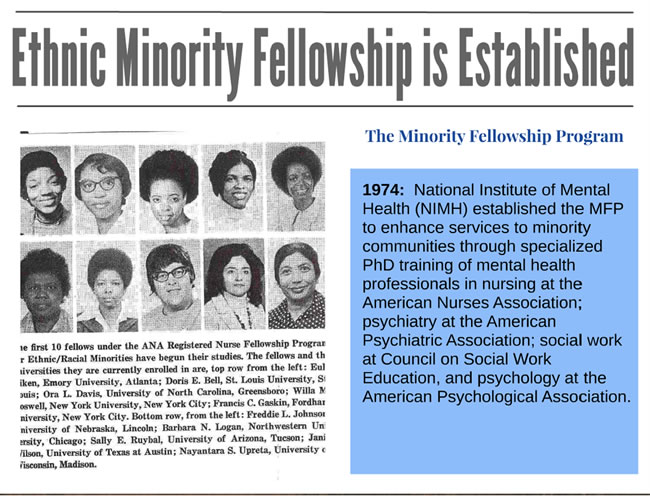The SAMHSA Minority Fellowship Program
Funding opportunities, through a grant from the Substance Abuse and Mental Health Services Administration (SAMHSA), are available and designed to support the training of future nurse practitioners in behavioral health practice, education and health policy. If you have the potential to be a leader and are committed to a career providing behavioral health services or developing policy for ethnic and racial minority populations, we invite you to apply to one of the following programs:
Minority Fellowship Program (MFP) Doctoral
Supported by the Substance Abuse and Mental Health Services Administration (SAMHSA), this program provides 3-5 year fellowships to masters prepared nurses, or nurses who have completed at least nine (9) credits related to Psychiatric/Mental Health or Substance Abuse and committed to pursuing doctoral study on minority psychiatric-mental health and substance abuse issues.
Minority Fellowship Program (MFP) Masters
Students admitted to or currently matriculating in a full-time accredited masters degree program in behavioral health (psychiatric nursing) or substance abuse disorders prevention and treatment.
Applying for the Fellowship? Learn more or login to the MFP Application Portal.
We're looking for mentors! Learn more or Log in to the Mentorshp Program.
Are you an MFP Fellow or Alumni? Learn more or Log in to update your profile.
Find NAC Reviewer resources or log in to the system to review applications.
Applicants
Call for Applications is now closed
The MFP is an initiative staffed by ANA with funding from SAMHSA, making fellowships available to all ethnic, minority, and racial psychiatric nursing students who are enrolled full time in an accredited master’s/doctoral nursing program.
Login into the MFP Fellowship portal..
History of the MFP
Racial and Ethnic Minorities make up more than 28% of the Nation's Population, yet less than 20% of America's Behavioral Health Workforce consists of these diverse populations.
This scarcity of professionals who are from culturally and linguistically diverse backgrounds constitute a workforce issue that contributes to the health disparities and quality of care and access to mental health care and or substance use treatment among minority populations.
In 1974, the National Institute of Mental Health established the Ethnic Minority Fellowship Program, a grant initiative, to enhance services to minority communities through specialized PhD training. NIMH awarded funding to the four core mental health organizations that included nursing at the American Nurses Association; Psychiatry, at the American Psychiatric Association, Social Workers, at the Council on Social Work Education; and Psychology, at the American Psychological Association.
Around 1994, NIMH transferred the Minority Fellowship Program to the Substance Abuse and Mental Health Services Administration (SAMHSA) which is a Division of the U.S. Department of Health and Human Services (DHHS).
In 2014, under President Obama's Now is the Time Initiative, SAMHSA expanded the Minority Fellowship Program to include the Minority Fellowship Program-Masters. The MFP-M initiative aims to increase the number of culturally competent Masters level behavioral health professionals available to serve children, adolescents and youth transitioning into adulthood ages 16-25.

.accordion-body, though the transition does limit overflow..accordion-body, though the transition does limit overflow..accordion-body, though the transition does limit overflow..accordion-body, though the transition does limit overflow.MFP Mentors
.accordion-body, though the transition does limit overflow..accordion-body, though the transition does limit overflow..accordion-body, though the transition does limit overflow.MFP Fellows & Alumni
.accordion-body, though the transition does limit overflow..accordion-body, though the transition does limit overflow..accordion-body, though the transition does limit overflow.NAC Reviewers
.accordion-body, though the transition does limit overflow..accordion-body, though the transition does limit overflow..accordion-body, though the transition does limit overflow.Key Dates
Previously Recorded Webinars
Contact Us
Your Organization NameYour Address
Your City / State / Province
Phone: Your phone #
Email: Your contact email

